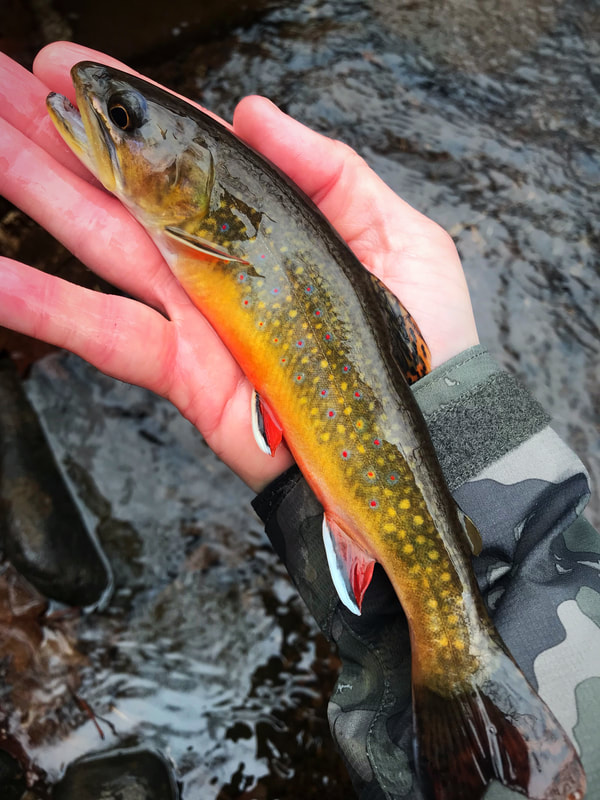This page is dedicated to the Virginia Native Brook Trout (Salvelinus fontinalis).
Most colorful of Virginia trout. Back is a dark olive-green with light wavy or wormy markings. Sides are lighter, sometimes with a bluish cast, yellowish spots and red spots with light blue halo around them. Belly is white with bright orange fins. Fins have outer edges of white with black line separating it from the orange. Ten to 16 inches and 1 to 2 lbs. is a good-sized brookie. Native brook trout seldom grow beyond 12 inches in Virginia streams.
For the purist, dry flies, wet flies, streamers, and nymphs are used. Nymphs early in the season, dry flies when the natural insects hatch. Caddis, mayfly, and stonefly nymphs also early in the year when these aquatic larvae are available naturally.
Brook trout feed mainly on insect larvae for most of their lives, including caddis and mayfly nymphs, but also on small fish and crayfish. Tend to be mostly daytime feeders.
Brook trout prefer colder, cleaner waters and smaller creeks. Tend to do best in water temperatures of 68*F or less.
Brook trout typically spawn in October and November in the headwaters of small streams, usually the tail of a pool. The female excavates a spot in the gravel and releases her eggs and the male releases milt over them at the same time. The female will fan a lose covering of gravel over the eggs to protect but not smother them.
Most colorful of Virginia trout. Back is a dark olive-green with light wavy or wormy markings. Sides are lighter, sometimes with a bluish cast, yellowish spots and red spots with light blue halo around them. Belly is white with bright orange fins. Fins have outer edges of white with black line separating it from the orange. Ten to 16 inches and 1 to 2 lbs. is a good-sized brookie. Native brook trout seldom grow beyond 12 inches in Virginia streams.
For the purist, dry flies, wet flies, streamers, and nymphs are used. Nymphs early in the season, dry flies when the natural insects hatch. Caddis, mayfly, and stonefly nymphs also early in the year when these aquatic larvae are available naturally.
Brook trout feed mainly on insect larvae for most of their lives, including caddis and mayfly nymphs, but also on small fish and crayfish. Tend to be mostly daytime feeders.
Brook trout prefer colder, cleaner waters and smaller creeks. Tend to do best in water temperatures of 68*F or less.
Brook trout typically spawn in October and November in the headwaters of small streams, usually the tail of a pool. The female excavates a spot in the gravel and releases her eggs and the male releases milt over them at the same time. The female will fan a lose covering of gravel over the eggs to protect but not smother them.
